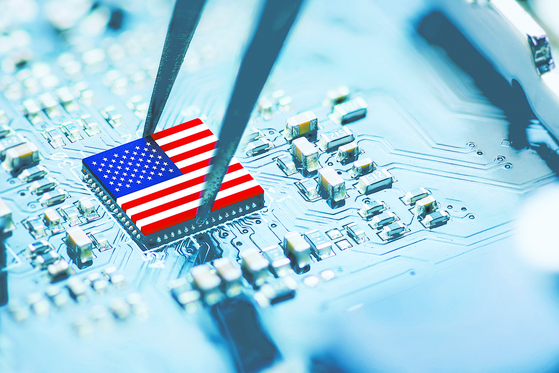Friend-shoring, not reshoring, is the answer

Kim Doo-sik
The author is CEO of Tech & Trade Institute and a lawyer.
The United States has gone all out to rebuild a chipmaking ecosystem on its home turf. The country aims to move beyond chip designing and strengthen the semiconductor manufacturing capacity it has relied on Taiwan, South Korea and others. The goal is to increase the global share of its chip production to above 20 percent by 2030 from the current 12 percent. The CHIPS and Science Act is intended to expedite the plan.
U.S. triggers subsidy race
However, achieving the goal may not be easy as expected. Major chip-manufacturing countries are also doing their best to develop the chip industry in their own country. It was the U.S. that triggered a global competition for chip subsidies to buttress its chip industry and capacity. Despite heavy curbs on exporting top-caliber semiconductors to China, Beijing’s chip ambition has not humbled. China is injecting more subsidies to accelerate its chip self-sufficiency than before. The European Union plans to spend 43 billion euros ($49 billion) under its own version of the U.S. CHIPS Act to raise its share of global chip production to 20 percent from less than 9 percent today.
In South Korea, memory giants Samsung Electronics and SK hynix will spend multi-billion dollars to create a massive chip cluster of foundries and fabs, backed by government incentives and tax breaks. Japan, which commanded the chip sector until the mid-1990s, is out to restore its past glory by focusing on systems on chips. Rapidus, an international chipmaking consortium based in Japan, is aiming to turn out 2-nanometer chips in a next-gen chip plant in Hokkaido. Tokyo effectively persuaded Taiwan Semiconductor Manufacturing Company, the foundry leader, to build two chip facilities in Kumamoto to meet the increasing demand for chips for image sensors and vehicle automation. Given such a heated contest, it won’t be easy for America to outpace others and reemerge as a chip powerhouse. Many hurdles await the ascension. The $52.7 billion subsidy and 25-percent tax credit alone cannot rebuild the chip manufacturing ecosystem in the U.S. A competitive chip habitat cannot be sustained unless its production cost falls as low as competitors’ and skilled workers continue to meet the demand for the workforce. That’s why it is essential for the U.S. to create an ecosystem in which highly competitive chipmakers from Korea and elsewhere can participate.
Going gainst market principles
The U.S. needs to reexamine its chip support program to raise the potential for the success of its ambitious policy. First of all, it must reconsider the provision of excessive demand for data from applicants for subsidies and tax credits. According to the latest Notice of Funding Opportunity by the Department of Commerce to spell out the requirements for subsidy under the CHIPS Act, all applicants are required to hand over detailed descriptions of their core technology, including on materials and expendables for their chip production, as well as their manufacturing capability — for instance, their production yield per wafer of different sizes, operation rate, annual output and changes in sale prices — plus financial details such as their projected cash flow.
Such demands are overbearing for a “business review.” A bigger problem is that foreign companies must regularly submit the data to the Commerce Department. If the U.S. really wants foreign players to join its ecosystem, their trade and manufacturing secrets should be protected. The unreasonable demand for their confidential materials should be withdrawn.

Second, the provision on profit-sharing also should be removed. The U.S. government says it will collect a portion of the chipmakers’ excess profits beyond their projection and use the money to rebuild a chip manufacturing habitat in the U.S. But the idea of setting a threshold based on their profit projection and collecting the surplus is nonsensical. Projecting profit in the rapidly fluctuating chip industry is difficult. Moreover, any excess profit needs to go to facility investments for chipmakers to keep ahead of the competition. A government claiming a share in profit as if it were a dividend for a shareholder — just because it provided a subsidy or tax break — goes against market principles or corporate laws. The U.S. government is treating foreign companies as if they were nationalized. The U.S. must chuck away the profit-sharing condition, as it can only dampen their investment will.
The best partner for chips
Third, the U.S. must pivot chip policy toward “friends-shoring” by leveraging on the strengths of its allies instead of “reshoring” for its own national interests. The U.S. wants everything related to chipmaking done on U.S. soil. But the U.S.-led reshoring policy can hardly succeed. The chip industry has been established through the division of labor around the world for decades, and a global ecosystem based on the separation of roles and collaboration has proven to be effective.
South Korea says it can go along with the U.S.-led chip order for security grounds as an ally. At the same time, the country, as a dominant memory supplier, has the capacity to complement the U.S.-led supply chain. And yet, South Korea does not monopolize a certain chip category like Taiwan, which takes up a whopping 92 percent of system chips. Korea can be the best partner for America to realize its global chip strategy.
The U.S. must see South Korea as a partner, not a competitor, and aggressively collaborate with the country in chip production. The U.S. must seek a mutually-beneficial path instead of chasing its own interests. The best way to achieve the goal will be “friend-shoring.”
Moderate the speed
The U.S. must give more time for South Korean chipmakers to adjust their production in China. Regardless of the U.S.-China conflict, China remains central to Korean companies. Samsung Electronics produces 40 percent of NAND flash memory in China, and SK hynix half of its DRAM chips there. China is also the largest market for South Korea’s finished chips, materials and equipment. If its chip production in China shrivels, Korea will have to bear a heavy blow. Last year, the U.S. banned Korea from exporting semiconductor production equipment and parts needed to make DRAM chips rated 18 nanometers or less and NAND flash memory with 128 or more layers, as well as high-performance logic chips for artificial intelligence capabilities. The restriction directly affects SK hynix’s Wuxi plant in China, currently manufacturing DRAM chips rated 15 nanometers, and Samsung Electronics’ Xian plant producing 128-layer NAND flash memory.
Under the guardrail provisions regarding subsidies under the CHIPS Act, companies receiving U.S. subsidies cannot expand their production capacity in China by more than 5 percent of their current level over the next 10 years. Since technological upgrade is impossible under U.S. sanctions, Korea’s production facilities in China will rapidly end up manufacturing semiconductors for general purposes.
The U.S. must give Korean chipmakers enough time to minimize their apparent losses from methodical restrictions on their chip production in China. The U.S. must extend the one-year grace period on export curbs to Korean companies for a considerably longer period. The grace period should be minimum three years, given the upgrade cycle for technology. Even during the extended grace period, the U.S. subsidy for Korean chipmakers won’t end up in China, as they are required to use the money entirely on the foundry plants they are building in the U.S. The subsidy has nothing to do with their memory chip plants in China.
Specify terms for joint chip development
Lastly, South Korea and the U.S. must set guidelines and a roadmap so that Korean companies and research institutions can join — and share — the outcome of their future chip technology research and development in America. A meaningful role of Korean players in the U.S. future chip technology and quantum computing research will give a strong cause for Korea’s active participation in the U.S.-led supply chain.
The U.S. plans to set up the National Semiconductor Technology Center (NSTC) to serve as an innovation hub for future chip technologies. The NTSC, a private-public consortium, is expected to take responsibility for drawing up a roadmap for future chips and standards. Washington is urging Korean chipmakers to actively participate in U.S.-led R&D programs.
Still, no clear guidelines have been set on the procedure and conditions for Korean chipmakers and institutes to join the research or share the outcome. The specifics must be laid out for effective cooperation between the two allies. Their collaboration in chip technology will certainly be instrumental in making the CHIPS Act beneficial for both countries.
Translation by the Korea JoongAng Daily staff.










with the Korea JoongAng Daily
To write comments, please log in to one of the accounts.
Standards Board Policy (0/250자)